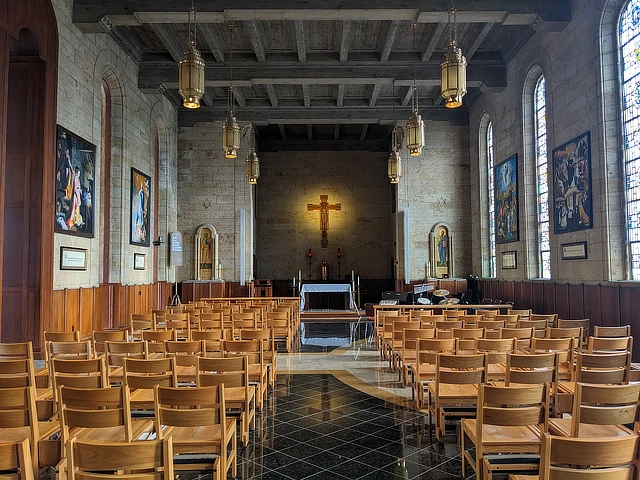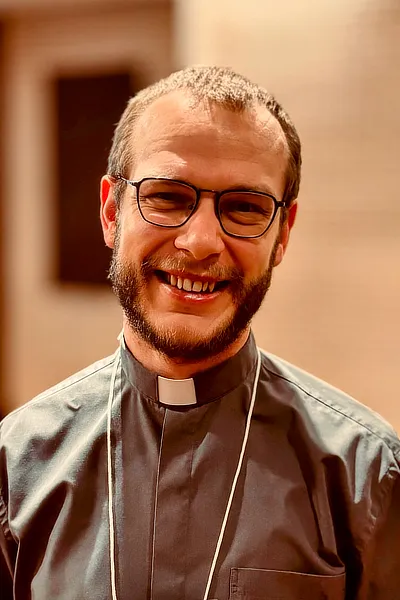
This summer, I was invited to be a guest researcher on a project studying youth and young adult participation in worship. As a part of this project, I completed five days of field research at the One Bread One Cup Conference, a liturgical leadership camp for Roman Catholic youth hosted at St. Meinrad Benedictine Abbey.
My name is Erik Sorensen, SJ, and I am a doctoral student at Saint Paul University in Ottawa, Canada, where I am studying liturgy. I am also a member of the Catholic religious order called the Jesuits. Being a Catholic priest and a vowed member of the Jesuit order, the liturgies I experienced through the One Bread One Cup conference were familiar to me, but even so, I felt utterly saturated by the end of each day. The five days we spent at this camp were a unique opportunity to explore and witness a wide breadth of Catholic liturgy. I can’t imagine what the students were feeling who had experienced a day filled with so many liturgies for the first time.
The liturgy-filled days stand in stark contrast to the experience of the average practicing Catholic. For most Catholics, their sole experience of liturgy is the Sunday Mass. In most North American communities, this celebration lasts at most one hour and follows a regulated pattern of prayer that changes little from one Sunday to the next. The five days at St. Meinrad’s Archabbey were a liturgical immersion for these high school students that they would not encounter at their home parishes.
To begin the One Bread One Cup experience, I managed to drag myself out of bed to the sound of the monastic bells at 5:15 a.m. and stumble over to the Archabbey church to join a small group of students and the monastic community in their morning prayer. The spacious church was dimly lit by the early morning sun as I took my seat. Soon after, the quiet and measured chanting of the monks filled the large church and gently inaugurated a day that would be punctuated by liturgical prayer
Throughout each day, there were at least six opportunities for communal liturgical prayer; most of these were led by the students themselves. The final liturgy of the second day was a late-night prayer service held in the seminary chapel, a smaller space than the grand abbey church. During this evening service, the consecrated bread was displayed in an ornate golden stand on the altar, dimly lit, with many candles spread throughout. Periods of contemplative music from the Taizé ecumenical community in France broke up the hour of silence while the students knelt or sat in prayer. Following this prayer service, the students took time to reflect on their experiences of the day in small groups.
At each of the services they attended, all the senses were engaged. Incense, music, ornate vestments, and processions all combined to create a rich tapestry of embodied experiences. One of the expressed goals of this immersion was for the students to be able to develop as liturgical leaders and share this experience in their home parish communities. And they had rich and varied experiences to draw on as they returned home.
Standing back and reflecting on this experience with a couple of weeks of distance, I am left with the question of how these young people are being formed by this intense liturgical experience. What are they taking away from those five days of liturgical immersion? Our research and the interviews conducted during this camp have started to produce insights into how these students experienced this liturgically saturated environment. For example, some students focused on reverence as being a central component of their experience of worship, wanting the services to be reverent to bring people closer to God.
Though it is still too early to draw any patterns or finite conclusions from this research project, I am immensely grateful for this unique opportunity to learn from young people. It is only by being immersed in this camp alongside these youth that it is possible to begin to engage with their experience on their own terms. What I learned from these young people will help me to be a better minister to the communities that I serve here in Ottawa.
“Young People and Christian Worship: Experiences, Stories, and Values” (YPCW) is a collaborative research project jointly sponsored by Saint Paul University, Ottawa, Ontario, and Samford University’s Center for Worship and the Arts, Birmingham, AL. It is a binational, multisite, ecumenical, mixed-methods exploration of how young people (13-18 and 19-29) experience public Christian worship. Primary investigators include Emily Snider Andrews, PhD, Nelson Cowan, PhD, and Sarah Kathleen Johnson, PhD. The YPCW study is made possible thanks to generous funding from Lilly Endowment, Inc., the Calvin Institute of Christian, and Baylor University’s Future Church Grant program.

Erik Sorensen, SJ is a doctoral student in theology at Saint Paul University in Ottawa, Canada. His research utilizes qualitative methodology to explore the lived connections between liturgy and Indigenous-Settler reconciliation in the Catholic Church in Canada. Erik is a member of the Society of Jesus (Jesuits) and a Catholic priest. He holds a MA in Theology from KU Leuven, a MDiv and an MTS from Regis College/University of Toronto.
For further reading on this project, check out:
Research at CWA: Big Things are Coming! by Nelson Cowan and Emily Snider Andrews
Awakening – The Impact of Worship Experiences on Young People by Mykayla Turner
